|
|
Kisbér

|
|
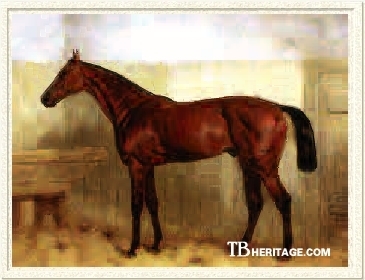 |
|
|
Kisbér was the Hungarian-bred winner of the Epsom Derby and Grand Prix de Paris, and the most dramatic representative of the thoroughbred breeding program instituted throughout Austria-Hungary by the Imperial stud, greatly enhanced by his English-bred sire, Buccaneer. Although at stud in England for nine years, and later a leading sire in Germany three times, Kisbér got few useful sire sons, and his influence on the breed is mostly limited to the descendants of his English-bred daughters.
His sire, Buccaneer, was a weight-carrying miler that won eleven races in England. Buccaneer had three seasons as a stallion before he was sold to the Hungarian Imperial stud, and he was two years gone when his 1865 and '66 crops put him at the top of the leading sires list in England. In Hungary, not surprisingly, he was the dominant stallion of his era, the sire of fourteen Derby winners in various countries and of progeny that won over a million dollars during his twenty-one seasons at Kisbér, the principal Imperial stallion depot. A champion stallion in Hungary, he also led the sires list in Germany, where many of his progeny raced, four times.
Kisbér's dam, Mineral (1863), was out of the flying Manganese, a brilliant juvenile winner of ten races and winner of the One Thousand Guineas at age three. Mineral was by the stayer Rataplan, winner of 42 of his 82 starts. Manganese was co-owned by Yorkshire trainer John Osborne and his client, Rev. John William King, who raced under the name "Mr. Launde." King later bought out Osborne's interest in her, and owned her as a broodmare. In addition to Mineral (first named Rubbish), she produced Great Yorkshire Stakes winner The Miner, several good broodmare daughters, and Mandragora (1860), useless on the turf, but superior in the breeding shed, producing a series of winners, including Doncaster Cup winner Mandrake, and the Adventurer sisters Agility (Nassau Stakes, Park Hills Stakes, etc.), Apology (One Thousand Guineas, Oaks, etc.), and Analogy (dam of the French stallion Elf).
Mineral won one race as a juvenile, running under the name of several owners, including the Reverend under the name "Mr. Launde." At age three she was sold to American Richard Ten Broeck, for whom she won the Avon Stakes at Warwick in her first outing at age three, and she was claimed for 200 guineas by Captain Machell. She passed through several more hands, running almost always at the selling level. At age three she won three races, including the Avon Stakes, in fourteen starts, which included a dead-heat at Newmarket where the stakes were divided and she took a walk-over. Her highest class race was Goodwood's Nassau Stakes, where she was third, with nine in the field.
Mineral retired as a broodmare to the Graham brothers' Yardley Stud, near Birmingham. Her first live foal was Wenlock (1869, by Lord Clifden), who would win the Doncaster St. Leger. Next came his sister, Siluria (1870, tail-female ancestress of the important American broodmare Boudoir II, by Mahmoud). The following year, 1871, with no foal at side, she was bred to Adventurer and sold to agents for the Hungarian Imperial Stud and sent to the Imperial stud at Kisbér. In 1872, in Hungary, she dropped her Adventurer foal, Schwindler, who would win the Deutsches Derby. Bred to Buccaneer, she produced a red bay colt, Kisbér in 1873. In 1877 she produced Kisbér Öscse, a full brother to Kisbér, that became a useful stallion in the Imperial stud.
Kisbér was described as "plain-headed," standing 15.3. hands, with a "muscular neck," "splendid" deep shoulders and "strong loins." His hocks were said to be, like his sire's, "coarse." He was purchased at the annual Kisbér Stud yearling auction for £500 by Alexander and Aristide Baltazzi, Turkish-born scions of a hugely wealthy extended family of Levantine merchants. Alexander, Aristide, and another brother, Hector (a notable amateur steeplechase rider), were educated at Rugby in England, and all three became enthusiastic participants in English racing, as owners and breeders in the 1870s. Alexander, in particular, also was a supporter of racing and breeding in Austria-Hungary. In 1884 he married Marie Stockau, acquiring her family's estate at Napajedla, located near Zlín in Moravia, Czechoslovakia. Two years later he established a successful thoroughbred stud there, where Kisbér was installed as a stallion, although he only spent two years there. Many successful winners at the Freudenau racecourse in Vienna came from Napajedla. After Baltazzi's death in 1914 Napajedla continued to send out winners, having a significant influence on Czechoslovakian racing until, suffering from over a decade of financial woes due to war and political pressure, it finally went bankrupt in the late 1920s, and the state assumed ownership of the property and of many of the horses.
Kisbér on the Turf
The Baltazzis sent Kisbér to England to train and race, under the direction of Joseph Hayhoe, who trained the English horses owned by Mayer and Leopold de Rothschild. Some time during his juvenile season Kisbér began to suffer from a version of arthritis or rheumatism in his joints -- he "had to be hunted around his box to take the stiffness out of his joints before he was brought out to exercise of a morning." He was carefully nursed to race in only the most prestigious of the three-year-old races. He ran seven times, four of them as a juvenile.
Kisbér, running unamed as the "Mineral colt," went to the post four times at age two. "Very backward," he did not place in his two races at Newmarket July. In a private trial, where Kisber easily beat Baltazzi's good horse Coeruleus (by Beadsman; a winner of the Great Eastern Railway Handicap and the Great Shropshire at Shrewsbury), giving him "lumps of weight," he figured prominently in the betting prior to the Middle Park Plate, with Baltazzi wagering heavily on him to the maximum allowed by the bookmaker. But, he ran unplaced in that race, won by the beautiful and talented, but erratic, Petrarch in his only juvenile outing, with the filly Madeira second. There was speculation that his rheumatism had flared up, unnoticed by Hayhoe. Another private trial, held after the Middle Park Plate, showed Kisbér to be far superior to a filly by Gong, that had been beaten by a neck and a nose into third place in the Prendergast Stakes; in the trial he "gave her two stone and a good beating." At Newmarket Houghton he was the surprise winner of the Dewhurst Plate, beating the favored Springfield by three lengths. It was no surprise to Baltazzi and his friends, with whom he had shared the results of his amazing trial against the Gong filly, and Baltazzi recouped all he had lost in wagering on Kisbér in the Middle Park Plate.
Kisbér was withheld from the Two Thousand Guineas (won easily by Petrarch), so his first public appearance at age three was at Epsom, where Petrarch was a warm favorite for the Derby. In the meantime, Baltazzi had run up a large debt with a moneylender who theatened to seize Kisbér and prevent his running in the Derby. Sam Lewis, another money-lender settled the debt that allowed Kisbér to run and provided an additional £500. Baltazzi was told there was a superstition that unnamed horses running in the Derby "were always dogged by ill-luck," and so a few days before the Derby, the Mineral colt, after some debate, was named after the place of his birth.
Kisbér won the Derby easily by five lengths -- one of the more dramatic endings to a Derby -- with two moderate horses, Forerunner and Julius Caeser (the latter second to Petrarch in the Two Thousand Guineas) coming in second and third, Petrarch trailing eleven lengths from the winner in fourth place, and the rest of the field behind him. It was an enormous upset, in every sense of the word. Kisbér was the first foreign-bred horse to win the Derby since the great Gladiateur had triumphed in 1862. Word of his triumph electrified the racing world in Vienna and Hungary. Baltazzi and his brothers reportedly cleared £100,000 in bets on the race.
His next target was the rich and prestigious Grand Prix de Paris (1 mile-7 furlongs), where he was stabled at Sir Richard Wallace's estate, Bagatelle, which had once belonged to Napoleon I, about a mile from the racecourse. "There," said a member of the Baltazzi entourage, "in the cool of the evening, we saw Kisbér walking round a large bed of corn-flowers in the garden..." Kisbér, in a good time of 3 minutes-22 seconds, once again won an important race "striding away" with ease, five lengths ahead of the French filly Enguerrande, who had dead-heated for the Epsom Oaks in England, with the rest of the field trailing. "The victory was not a very popular one, owing to an erroneous idea amongst the French that the horse belonged to a German," said an Englishman who witnessed the race.
Kisbér was brought back to England to challenge for the Doncaster St. Leger in September. He started the favorite at odds of 2:1, with Petrarch next favorite. Kisber bounded away at the start, and after half a mile took the lead, right up to the distance post, "where he collapsed." The race was won by a neck by Petrarch, in a hard-fought finish with Wild Tommy (by King Tom), with Julius Caesar third, and Kisber fourth, followed by four others. "As to Kisber's running and his most extraordinary defeat, we hardly know what to say...the horse was pulling Osborne out of the saddle one minute and was done with the next," wrote one turf writer. His defeat was chewed on in the press after the race, and for some years thereafter; one who witnessed the race said "he overpowered his jockey and ran himself to a standstill;" some blamed his defeat on his rheumatism; one said he had injured the "pan of his heel," and his jockey, John Osborne later claimed he had been "got at," stating he was "beaten before he even started." He was slated to run in the Select Stakes and the Cesarewitch that fall at Newmarket, but was scratched.
There is no record of his racing in 1877, although he was entered to run in some early closing races. It may be the reported injury to the "pan of his heel" was a training accident that forced his retirement, or perhaps his rheumatism terminated his career; sources on this are silent.
Kisbér in the Stud
Kisbér spent the 1877 season as a stallion at Park Paddocks in Newmarket at a fee of 50 guineas, where he got a very small crop. In 1878 he moved to Mayer de Rothschild's Crafton Stud at Mentmore; the Baron died that year, but Kisbér remained there through 1880, and in 1881 went to Leopold de Rothschild's (the Baron's nephew) Ascott farm, where Rothschild had recently established his Southcourt Stud, near Leighton Buzzard in Buckinghamshire. Kisbér stood there, still at 50 guineas, until Baltazzi completed furnishing the stud farm at Napajedla, in Moravia, and Kisbér went back to central Europe in 1886 as the stud's principal stallion. Two years later he was moved again, to Gestüt Harzburg at Bad Harzburg in Lower Saxony, where he got most of his German winners, and where he died.
Kisbér is usually described as a failure as a stallion when in England, but he was actually a fairly consistent sire whose moderately successful offspring placed him 15th on the sires list in 1884, 8th in 1886, and 16th in 1887. Still, he was hardly the kind of progenitor expected of a Derby and Grand Prix de Paris winner, and he saw some high-class mares from Mentmore, operated by Rothschild's relative-by-marriage, Lord Rosebery, and yet failed to get a truly superior racehorse in England. In Germany he led the sires list in three successive years towards the end of his life, 1894-96. While he got good racing sons in Germany, none of his English or German colts established successful sire lines. However, he was influential as a broodmare sire, getting the dams of the French classic winners Ragotsky and Semendria, of the great stayer Bachelor's Button, of the successful Italian sire Galezzo and Taia (dam of Radium), of the American stakes winners Racine and Fairy, and the dams of good winners in Germany.
CRAFTON (1882, out of Chopette, by North Lincoln), bred by Lord Rosebery,was one of Kisbér's better racing sons. His dam, the "flying" Chopette, had established her racing credentials for Baron Mayer Rothschild by winning three races at age three at Newmarket, and placing several times, and at age four taking a handicap sweep, beating six, at Newmarket, placing second in Newmarket's Rous Stakes to Prince Charlie and second in Ascot's New Biennial Stakes to Kaiser.
CRAFTON, a bay standing 16 hands, raced for William Gerard, later Lord Gerard, and his metiér was a mile or less. He won one race, the Halnaker Stakes, at Goodwood, as a juvenile. He most famously almost won the Two Thousand Guineas at age three, beaten by a short head, and would have won had he not been "sorely," "flagrantly," intefered with near the finish of the race by Fred Archer, who was riding Paradox, the ultimate winner. "There was a very animated discussion as to whether Captain Machell [who "had charge" of Crafton] would object. It was rather reluctantly decided not to do so, however, and Paradox was allowed such honours as accrued to the victory." He was unplaced in Melton's Derby, and third in Ascot's Hardwicke Stakes to Bendigo, with seven in the field. At age four he ran eight times, and won three -- the prestigious Steward's Cup at Goodwood, beating twenty-four other horses; Brighton's Marine Stakes (5 furlongs, beating 14), and the Peveril of the Park Plate handicap at Derby, worth 1,000 sovereigns, over a mile, beating fifteen. He was also second that year in the 1,000 guineas Welbeck Cup at Derby (5 furlongs) to Kingswood, with sixteen others in the field, but he could not place in the higher class handicaps, such as the Lincolnshire Handicap and the City and Suburban.
CRAFTON went to stud at Captain Fife's Compton Stud, located at Sandley, Dorsetshire; it had begun as a hunter stud, where thoroughbred stallions were crossed on half-bred mares to produce hunters, which were successfully shown all over the country. It was later expanded to include a thoroughbred racehorse stud, where CRAFTON, Amphion and Avington held sway as stallions. He stood for a "ridiculously low sum of five guineas, and as people not unnaturally fancy that what is offered to them for nothing must be worthless, breeders fought very shy of him."
CRAFTON got some winners, including Craftsman, Freak, and Irish Car, but his long-term influence was through his daughters, notably Alveole and Grig. Alveole (1889, by from St. Alvere by Hermit), was a modest winner of three races at age two and one at age three. In England she produced Lucious (1894, by Royal Hampton), winner of three races at age two and also three races at age three -- her maximum winning distance 5 furlongs -- and later dam of some good producing daughters, including Lisma, the dam of Omar Khayyam. Alveole was sold to Germany where she got six high-class winners, among them Aklang, Abwechslung, and Antwort; through her offspring she became one of the most signficant of German matrons.
CRAFTON'S daughter Grig (1892, from Merrie Lassie, by Rotherhill), won the five furlong Croxteth Plate at Liverpool and Kempton Park's Middlesex All-Aged Plate (where she was claimed by Leopold de Rothschild), and at age three Newmarket's Snailwell Stakes, Doncaster's Portland Plate, and five other races carrying high weight. She became the dam of Santa Fina (1907, by St. Frusquin) -- the dam of Grand Prix de Paris winner Galloper Light (1916, later sire of two Oaks winners and many other good daughters) -- and of St. Anton (1908, by St. Frusquin), an influential stallion in Australia that got over thirty stakes winners over all distances, mostly in southern and western Australia.
Not surprisingly, given where he was located, CRAFTON also got some good half-bred horses. He was the sire of Hulcot (1897, from Queen of the Riding, Family HB-2), a useful juvenile that later won the Great Cheshire Handicap, the Queen's Prize at Kempton, and the Long Course Trial Plate at Newmarket. He also got the unraced Handicraft (1892), the dam of five winners on the flat and over fences, including Doncaster Spring Handicap winner Artisan (1906, by Eager), who also won over hurdles; Apprentice (1909, by Symington), winner of five races, including the Hastings Plate, the Lingfield Park Stakes and the St. Albans Handicap; and Handspike (1898, by Simontault), who took Newmarket's Flying Handicap, Brighton's Marine Plate, and another race, and later bred a couple of winners before being sold to Austria.
KINSKY (1881, from Illuminata by Rosicrucian) was another useful runner by Kisbér bred by Lord Rosebery. When Rosebery dispersed many of his horses in training in 1885, Kinsky was picked up by a John Crewe-Read, as was his brother, KAUNITZ, who was the sales-topper at 2,000 guineas. KINSKY'S wins included Sandown's Esher Stakes (one mile, beating five), Ascot's High Weight Plate (1-1/4 miles, beating five), the Chester Cup (2-1/2 miles, carrying 8 st.-12 lbs. when he was age seven), and the Prince of Wales's Cup, worth 500 sovereigns, at Kempton Park (one mile, beat seven).
DUCAT (1882, out of Duchess of Parma, by Parmesan) was purchased by the French owner C.J. Lefèvre, and won some good races, including Ascot's Mid-Summer Stakes, Newmarket's Grand Duke Michael Stakes (beating Florin), the Newmarket Biennial, and the Prince of Wales's Stakes at Newmarket. He later was sent over fences, winning the Great Sandown Hurdle Race (2 miles, beating five) and the Sandown Grand Prize (2 mile hurdle, beating eight). HUNGARIAN (1882), a gelding, won seven races for trainer Robert Peck at age three, at Manchester, Epsom, Ayr, Sandown, Brighton and Four Oaks, and like DUCAT, was later sent over fences, winning the Liverpool Hurdle Handicap (2 miles) at age four.
Kisbér's son ARCADIAN (1883, from the classic winner Spinaway), bred and raced by the Duke of Portland, won a sweepstakes at Newmarket First Spring and a race at Doncaster at age three, and at age four the Blankney Stakes (one mile, beating four), the Lincolnshire Handicap (one mile, beating eighteen, including CRAFTON), and the Bennington Stakes at Newmarket. HARMATTAN (1882, from North Wind) won Epsom's Belmont Stakes, Brighton's Ovingden Plate, and several other races. None of these, nor any other Kisbér sons in England, excluding CRAFTON, left a mark as a stallion. ARCADIAN was sent to Napajedla when he was done racing to replace Kisbér; his best runner was Flugschrift, a winner of the Schwarzwald-Rennen at age two.
Kisbér's English daughters were a pretty modest lot as runners; while most raced, few were winners of anything much beyond selling stakes. One of the few exceptions was DAMIETTA (1881, from Equinox by Favonius), a winner of the Great Yorkshire Stakes (1-1/2 miles). Other than that his winning daughters included: SNACK (1881, from Fasting Girl by Broomielaw) won races at Edingburgh and Newmarket; ASTOLAT (1882, from Bellicent by Cremorne) won at Hampton and Sandown; GISELA (1880, from Queen Margaret) won three races at age five in nine starts, at Catterick Bridge and Pontefract. SAGITTA (1883, from Stray Shot, by Toxophilite), supposed to be a top juvenile and expected to win the Prendergast Stakes, but she did not win in either start as a juvenile, and failed to win in six starts at age three. CZARDAS (1883, out of Lady of Mercia by Blair Athol), dropped in France when her dam's owner, Lord Falmouth, sold many of his good broodmares to France, won the Prix de la Masselliéte (for juvenile fillies at Chantilly, beating 14). And so on. Some of his daughters, however, made up for their moderate form on the turf in the breeding shed.
FAIRY ROSE (1880) was out of the Rothschild mare Hippolyta, a winner of the Ascot Stakes, by King Tom. In 1885 FAIRY ROSE was one of twenty of English mares purchased by Californian Leland Stanford and shipped to his Palo Alto Stock Farm in the San Francisco Bay Area, where she became a famous broodmare, regionally, if not nationally. She was bred to a succession of indifferent stallions -- Bishop, Argyle, and imp. Cheviot (from Australia), among others -- yet produced several good runners, and one record-setting colt.
FAIRY ROSE'S son, Racine (1887, by Bishop), was, along with Flambeau (1887, from imp. Flirt and by Wildidle), the best the Stanford stables ever turned out, and the two of them could not be beaten in California in 1889 and 1890. Racine won eleven of his twelve starts at age two (in California), beating his stablemate Flambeau on five different occassions. The next year Flambeau was the better runner, twice beating Racine, who, true to his heritage, was a flying miler and not a stayer; between the two of them, they took every major race in the state. With Flambeau the apparent better horse, Stanford leased out Racine, who was then enaged to run in the "east" (e.g. Chicago). Flambeau broke down soon after winning the 1-1/2 mile Pacific Derby (beating Racine by two lengths), and Racine went on to win six successive races, although only one was in California. His most impressive race at age three was in June of 1890, when at Washington Park in Chicago he ran a mile in 1:39-1/2, breaking the record set by Ten Broeck thirteen years earlier. His record at age three was 16 wins in 19 starts. At age four Racine won 15, including Chicago's Oakwood Handicap, of his 28 races, beating the fastest horses of his day, despite poor riding on many occasions and his relentless schedule. He was not a success at stud.
FAIRY ROSE also produced Fairy (1888, by Argyle). This filly won twenty good races, including the Palisade Stakes at Morris Park (New Jersey). Fairy went on to produce Indian Fairy (1897, by Iroquois), a winner of the Gazelle Stakes and the Matron Stakes in the east. FAIRY ROSE was one of the few mares bred to the great Ormonde while he was in California that produced a foal, in this case a filly, Rosormonde (1895), that won seventeen races in 82 (yes, 82) starts between the ages of two and five in California, including the May Day, Paxton and Christmas Handicaps. In 1899 FAIRY ROSE, age 18, and Racine, who had been retained in at the Palo Alto Stock Farm as a stallion, were sold at auction in New York, along with the rest of the farm's thoroughbreds.
Kisber's daughter ASTOLAT (1882), another Rothschild product, also went to the U.S., first in the Dixiana Stud in Kentucky, and then at the Woodlands Stud in Missouri, where she produced Royce Rools (1915, by Salvation), a gelded winner of the Bowie Handicap.
|
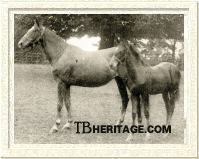
Eira with a Galopin foal
|
|
EIRA (1881, from Aeolia, by Parmesan), was bred and raced by Leopold de Rothschild, and descended from a Rothschild foundation mare, Mentmore Lass (1850, by Melbourne). She won seven races as a juvenile, and was pulled out of training in the middle of her second season. She was similar in appearance to her sire, with excellent bone and a broad chest and sturdy frame, but unlike Kisbér was tied-in below the knees. At Southcourt she produced Galeazzo (1893, by Galopin) and Taia (1892, by Donovan). Galeazzo won four races in eight starts at ages two and three, including the ten furlong Newmarket Stakes (substituting for St. Frusquin, who was lame), beating Bay Ronald and thirteen other good ones.
|
After his tendon gave way during the Newmarket Stakes, Galeazzo was retired to stud and sent to the Rothschild Haras de Meautry in France, but was sold on to Count Felice Sheibler, a successful Italian owner and breeder. He spent most of his stud life in Italy, but was back in England for a brief time, where he got the 1911 One Thousand Guineas winner Atmah (1908). In Italy he sired a number of classic winners for the Count, and was in the top five in the leading sires list there several times. His son, Kibwesi (1913), a versatile winner of twelve of his thirteen races, was a leading sire in Italy, and a daughter, Giottina, was the dam of three Italian classic winners.
EIRA also produced Taia, a non-winner that, to the cover of Bend Or, produced the grand stayer Radium, winner of the Goodwood Cup and Doncaster Cup at age five. As a stallion at Southcourt Stud Radium got Two Thousand Guineas winner Clarissimus (1913), an important broodmare sire, and other good winners. Radium's son, Night Raid (1918), was sold to Australia, and later moved to New Zealand, where he got the immortal Phar Lap. Radium was also a useful broodmare sire.
|
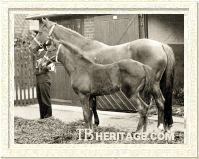
Guinevra with Guisia, a Lactantius foal
|
|
GUINEVRA (1883) was out of the Rothschild Epsom Oaks winner Hippia. She was an exceptionally pretty mare, easily 16 hands, with Kisbér's excellent shoulder, but she was born crooked, and in an era before stripping, never came completely right, turned out in both front legs, more notable in the left. She never raced, and since she was by a Derby winner and out of an Oaks winner, she was put in the Southcourt Stud broodmare band, although from the stallions she was bred to, it appears she was employed to try to (unsuccessfully) improve second-tier horses at Southcourt, rather than maximize her potential by breeding to top class stallions.
|
GUINEVRA'S best foal was Gulistan (1893) by Brag, a stallion at Southcourt, and he was probably Brag's best winner. At age two he won Newmarket's Ashley Plate (beating 14) and the Wilbraham Plate, and placed second to St. Frusquin in the Royal Two Year Old Plate at Kempton Park. At age three his wins included a free handicap at Newmarket, beating Oaks winner Thais, Bay Ronald, and five others by 3/4 os a length, and was second to Canterbury Pilgrim in the Jockey Club Cup, and at age four he won Newmarket's Lowther Stakes (1 mile - 2 furlongs), beating two others carrying 8 st.-13 pounds.
Kisbér's daughter CZARDAS (1883, from Lady of Mercia) was a modest winner in France, but a successful and significant broodmare. At Baron de Schickler's Haras de Martinvast, near Cherbourg, in France, she produced Ragotsky (1890) and Hungaria (1893) (both by Perplexe), and Semendria (1897, by Le Sancy), the best of her generation at age three. Ragotsky took the Prix Hocquart, the Prix du Jockey Club and the Grand Prix de Paris, and put his sire, Perplexe, at the top of the sires list in France in 1893 with those wins. His sister Hungaria established a female family that bred on through the mid-twentieth century, and included the famous Russian horse, Anilin (1961). Semendria won the Poule d'Essai (French One Thousand Guineas), the Prix de Diane (French Oaks), the Grand Prix de Paris, and several other races at age three, and among other wins at age four, took the Grand Prix de Baden-Baden. Her daughters continued her tail-female line, which included some excellent stakes winners.
MILADY (1886, out of Alone, by Hermit) raced for Lord Wolverton. As a juvenile her best was second, by a neck, in a nursery handicap at Epsom. She did not place at age three, and at age four was put over hurdles, winning a race at Wye, in Kent. She was a broodmare at Hampton Court Stud for several years, and was sold at its dispersal for 165 guineas (with a Town Moor foal at foot) to Lord Annaly, who sent her to Ireland. A couple of years later she was purchased by Joseph Lowry for 45 guineas and sent to Winkfield, who was standing at stud near Lowry's Bachelor's Lodge at Navan, Co. Meath.
MILADY'S Winkfield colt was Bachelor's Button (1899), an extremely tough, sound colt that withstood heavy training and raced through age seven, winning sixteen of his 43 starts, almost all of them high-class handicap races. He was a terrific racehorse, and a terrible stallion. For Lowry in Ireland he won the National Produce Stakes at the Curragh as a juvenile, and at age three the two mile King's Plate at the Curragh, and in England the Haydock Park Autumn Handicap (1-1/4 mile), the Manchester Welter Handicap (1-1/4 mile) and the Castle Irwell Handicap (Manchester, one mile). At age four he failed to win, but was second to Fighting Furley in the Liverpool Spring Cup, after which he was sold to Sol Joel for 2,000 guineas. At ages five through seven he won ten races worth £13,744, including the Ascot Gold Vase (2 miles), twice, the Liverpool Summer Cup (1 mile-3 furlongs), the rich Hardwicke Stakes at Ascot (1-1/2 miles), the Doncaster Cup (2 miles), the Manchester Cup and the Ascot Gold Cup (2-1/2 miles, beating the famous Pretty Polly). He went to Joel's Maiden Erlegh Stud near Reading with a stud fee of £98, and was feverishly sought after until his first crop hit the turf in 1910. None of them won. The next year he had one winner of a small plate. He got seven crops in England, from which there were winners of 28-1/2 races worth £7,935. He was a complete failure as a stallion, and was sold in 1912 to the Duc Decazes and sent to Haras du Mesnil in France, where he was also useless; he died in 1916.
Many of Kisbér's other English daughters established both short and long-lived tail-female families that included stakes winners. KISBERINA (1882, from Palace, by Macaroni) produced Prix Ganay winner Kremlin (1897). SANDAL (1885, out of Shoestring, by Knight of the Garter), was second dam of Ascot Gold Vase winner Charles o'Malley (1907, by Desmond) and his half-sister, Simon's Shoes (1914, by Simon Square), the latter a tail-female ancestress of an enormously successful female family that included the great broodmare Rough Shod (1944) and numerous classic winners and important stallions, such as Windsor Slipper, Nureyev and Sadler's Wells. EMMELINE (1882, from Evelina), had two daughters with successful branches in Australia and New Zealand: the 1982 Australasian Oaks winner Royal Regatta and the 1937 Victoria Oaks winner Prairie Moon both descended from EMMELINE. BELIMPERIA (1883, from Ambassadress by Queen's Messenger) was tail-female ancestress of the excellent Italian runner Pilade (1930) and the Prix de l'Arc de Triomphe winner Crampon (1930). TIT FOR TAT (1884, out of Reparation by Restitution) is seen tail-female in 1957 Canadian Derby winner Spangled Jimmy, 1951 Kentucky Derby winner Count Turf, and the French speedster Lianga (1971).
Kisbér in Europe
At Napajedla Kisbér got some winners and useful daughters. Through his Harzburg-bred progeny, he led the German sires list in 1894, 1895, and 1896. As in England, his sons were better runners than his daughters.
REALIST (1890, out of Relic, by Rosicrucian), born at Harzburg, won the Hamburg Criterium. He went back to Harzburg as a stallion, where he got Real Scotch (1901, from Schottland, by Chamant), the almost unbeatable 1904 champion runner in Germany whose wins included the Henckel-Rennen, the Deutsches St. Leger, the Hohenloe Oehringen Rennen, and the Alexander Rennen.
REALIST'S half-sister, Alpheda (1882, by Savernake), bred three good runners to the cover of Kisbér: ASCHE, UNDOLF and STEINBOCK. ASCHE (1892), raced by W. Hiestrich, won some good races at age four, including the Langer Hamburger Ausgleich at Hamburg, the Wäldchens-Rennen at Frankfurt, and the Omnium der Steher at Hoppegarten. UNDOLF (1893), owned by Baron F. Hohenlohe-Oehringen, won the Hoppegarten's Goldene Peitsche at age three. STEINBOCK won the Omnium der Steher at the Hoppegarten. Alpheda also produced Altgold (1895), by Kisbér or the French-bred Gouverneur, also a stallion at Harzburg; he won the Henckel-Rennen at Hoppegarten, and a number of other races.
HARDENBERG (1890, from Blue Mountain by Young Melbourne), bred at Harzburg and raced by R. Spiekermann, was Kisbér's first Deutsches Derby winner, and also won the Grosser Preis von Berlin that year.
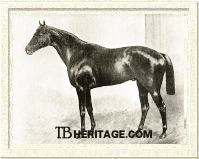
Ausmärker
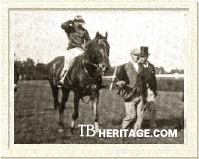
Trollhetta
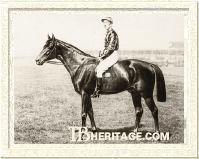
Sperber
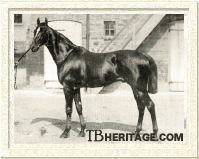
Sperbers Bruder
|
|
AUSMÄRKER (1891, out of Santa Maria by Isonomy) won the Grosser Preis von Berlin in 1894, and the next year took the Goldene Peitsche at Hoppegarten. He went to stud at the venerable Marbach State Stud at Weil, Wurttemberg, which had been lovingly devoted to the improvement of work horses and the breeding of arabians for many years. When Wilhelm II assumed the throne in 1891 the focus shifted to thoroughbreds, but the quality of the thoroughbred stallions and mares was not particularly high, and AUSMÄRKER, who got a few winners, was not a success at stud.
Kisber's son TROLLHETTA (1893, from Village Queen by King Lud) was Harzburg's most successful product during his time there. Purchased and raced by Baron E. von Falkenhausen, at age three he was unbeaten. His ten wins, including the Deutsches Derby and the Grosser Hansa Preis at Hamburg, made him the champion runner of 1896. At age four he took the Silbernen Schild (4700 meters) at the Hoppegarten in Berlin. He got some winners as a stallion, but none matched his record, and he died early, at age ten.
SPERBER (1891, from Vitarba, by Rosicrucian) and his brother, SPERBERS BRUDER (1895) were bred at Gestüt Eisfeld, at Bockstadt, Germany, owned by Baron von Münchhausen. SPERBER won the Criterium at Hamburg and the Hahn-Memorial before slightly injuring himself as a juvenile, and was one of Kisbér's Deutches Derby winners at age three, and went on to take the Godlene Peitsche at Bad Doberan, the Staatspries III Klaasse at Frankfurt, and the Sachen-Weimar-Rennen at Baden-Baden. At age four he won the Silbernen Schild (Silver Shield) at the Hoppegarten. In all, he won eleven of his 20 starts to age five. He died in September of 1896 when he was inadvertantly killed by a veterinarian that was treating him.
At age two SPERBERS BRUDER won the Prix de l'Avenir in France, beating Habenichts, later the three-year-old German champion. At age three he won the Grosser Preis von Hamburg, and dead-heated with Magister in the Grosser Preis von Berlin. He went back to Bockstadt as a stallion when he retired from the turf.
Some other Kisbér winners bred and raced in Germany included: SENNOR (1889), winner of the Schwarzwald-Rennen at Baden Baden; MA (1889), a winner of the Omnium der Steher at Hoppegarten, and IMM (1896), another winner of the Schwarzwald-Rennen.
|
Kisbér's German producing daughters included SANTAELLA (1889), the dam of Fürstenberg-Rennen winner Nicosia (1895, by Nickel), and WINDSBRAUT (1890) -- a grandaughter of the noted broodmare Das Veilchen -- who produced the Fürstenberg-Rennen winner Winfreid (1897, by St. Gatien).
--Patricia Erigero; special thanks to Tim Cox |
|
|
|

